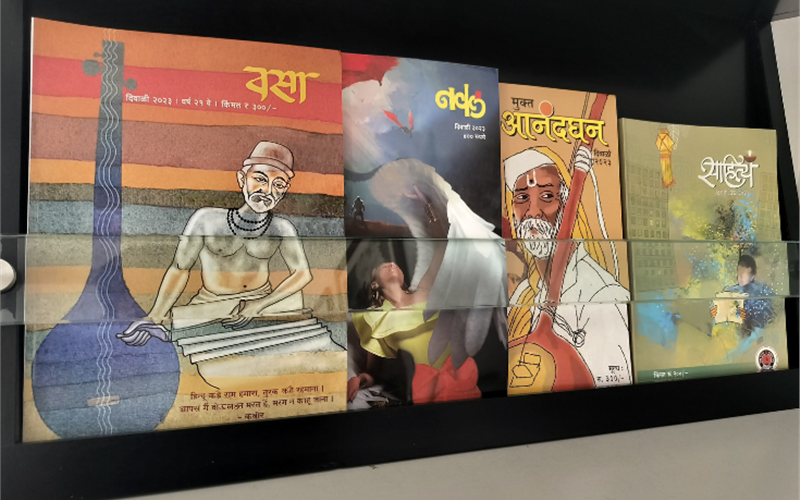Diwali is incomplete without the Diwali Ank
Every Diwali season is a time for an important Diwali tradition - the Diwali Ank! Every year at this time, publishers produce a Diwali special issue that is treasured. Anand Limaye of India Printing Works who printed 26 Diwali Ank this year, spotlights the tradition
17 Nov 2023 | By Anand Limaye
A Marathi person does not feel that the festival of Diwali has been celebrated without Diwali Anks in hand. Diwali issues with aesthetic covers like Vasant, Manohar, Hans, Kistrim along with colourful rangolis in the courtyard and hand-woven tablecloths in the house, the Marathi home atmosphere of a few years ago still remains. Today, only the hand-embroidered tablecloth with Diwali pharal (savouries and snacks) is left on the table.
But even today the Diwali Ank is like a near-and-dear relative who visits home every Diwali. Although its form and avataar have changed, its place in Maharashtra is intact. A reader who comes to the library reads multiple books throughout the year, but during Diwali he does not feel comfortable unless he possesses a Diwali issue at home.
The history of this Diwali issue is interesting. Kona Kashinath Raghunath Mitra initiated a magazine called Manoranjan in 1895 in Bombay. The surname of this trend setter (an aficionado of Marathi literature) is Aajgaonkar. He was a teacher in Sawantwadi, and he collected empirical data and literary tidbits as he tracked down one literary city. His aim: to satiate his passion for literature. Finally Aajganokar reached Mumbai. That too after he walked for eight days, nonstop.
But on reaching there, the problem of food and water arose. So then he worked for a few days in the post office rendering service of writing letters of people, especially money orders. There, Ajgaonkar met a Bengali man surnamed 'Mitra'. He taught Bengali to Ajgaonkar and in two years, Ajgaonkar started literary services by translating Bengali literature into Marathi. In the meantime, Mitra got to see a Christmas Special called ‘Joy of London’ that arrived by parcel from London.
And it was from this that he got the idea of creating the Marathi Diwali Ank. And that's how, in 1909, the first Diwali Ank of Marathi literature which was called 'Manoranjan' was born. As guru dakshina for this, Ajgaonkars adopted the surname Mitra. Since then he came to be known as Kashinath Raghunath Mitra. The first Diwali Ank was priced Rs 1/-.
In the first issue, all 192 pages, it is special that the progressive women writers were the A-Listers. Women social reformers like Kashibai Kanitkar, Lakshmibai Tilak, Chimanabaisaheb Gaikwad highlighted the importance of women's education in the Diwali Ank. Later top quality literature (prose, poetry, plays) became popular and it included seminal work on classical, social and cultural content. Ovalani Ghali Bhai (Brother giving gift to sister was the ritual) was the first poem by Balkavi to be published in the same issue; the first issue published in 1909.

Seeing the popularity of Diwali Anks, many publishers (magazines and literary houses) in Marathi language started publishing Diwali Anks. Along with well-known writers' stories, poems, political articles, cartoons, arts and sports, painting, sculpture, reviews of films and plays etc. from the country and abroad were included. The thumb rule was high literary value. Over time, Diwali Ank emerged as an independent literary form in Maharashtra.
Later, ideological essays, interviews, travelogues, autobiographical short stories, one-act plays etc. were added to it. Diwali Anks made a significant contribution to the Marathi literature sector. Many famous writers, poets, literary debutants came forward from the Diwali issue itself. Honored with the Jnanpith Award, Maharashtra's great writer Shirwadkar's well-known play Veej Mhanali Dhartila (Lightening speaks to Earth) was published in a Diwali issue.
Diwali Anks offer the pleasure of reading multiple types of genres, from fiction to nonfiction in one magazine. Diwali is not only reading Diwali issues, but also just browsing through them is very enjoyable. Everyone in the family used to read, but it soon became old. But there is a new joy in reading these old issues too.
About 500 Diwali Anks are published in Marathi every year. In the tradition of Diwali numbers, 1921 to 1960 and 1961 to 1980 would be called the golden era. During this period, Diwali Anks like Karmayogi, Kirloskar, Stree, Manohar, Satya Katha, Vangmay Shobha, Ramya Katha etc. were the superstars. Almost every household in Maharashtra boasted of a copy. In the later era, Diwali Anks such as Mauj, Vishakha, Rasik, Nihar, Amrit, Prapanch, Menka, Maher, Dhananjaya, Awaz, Prasad, Grihashobhika, became popular. Now Diwali Anks are published by mainstream newspapers such as Loksatta, Maharashtra Times, Lokmat, Tarun Bharat, Sakal.
Much has transformed in the last century. Economy, politics, and society have altered. Accordingly, our way of life, values and language have also undergone an upheaval; The social media era has arrived. The combined effect of all these is visible in the interior and exterior of Diwali Anks. Some printed Diwali Anks have gone digital. The new generation accesses Diwali Anks on their tablets and computer screens while the old generation savours good old-fashioned ink-on-paper Diwali Ank. Non-Resident Indians read Diwali Anks with tremendous interest. Some literary lovers have spread the glory of Marathi Diwali Anks overseas as well. Some gen-next have created an audio-visual Diwali Ank on YouTube.
Whatever the reason, the cultural bond between Marathi Manoos and reading is eternal, let me hope that no matter how the format of Diwali issues alters, the Marathi Manoos will not let this rich tradition be dented ...












 See All
See All